Assimilations: John Feodorov’s new exhibition

“I am for an art that kicks my soul in the ass. And if we do not have souls, I am for an art that makes me feel like I have a soul, and that it has just been kicked in the ass.”
John Feodorov is always provocative and outspoken on the subject of racism and colonialism, but he mixes it with humor to lighten the blow. He has also used animals frequently as a stand in for white people’s differences from Native beliefs. We make toys of them, while Native people see them as spiritual, creative and embedded in life.
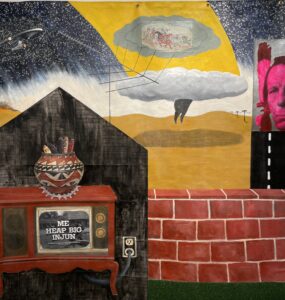
His recent exhibition at 4 Culture “Assimilations” explores the idea of his own mixed background, which he has done indirectly before in other work, but now he foregrounds himself and his family. His mother, a Navajo (Diné) converted to Jehovah’s Witness. “Assimilations” ( I feel there should be double quotes there, as title of show and the fact that he is showing its complexities). He is saying that assimilation
” forces an inherent contradiction within the colonized. Not unlike what Franz Fanon wrote about in Black Skin, White Masks. At least that has been my experience. Some embrace assimilation, while others, like me, cannot make our peace with it. It’s always about not being enough. In my case, not Navajo enough, and certainly not white enough.”
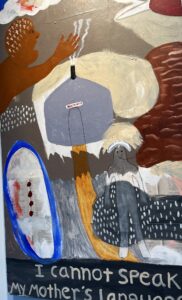
He calls himself a suburban Indian. Buried within his paintings are photographs of boring suburbs in Whittier, California where he grew up. He had two types of contact with Native culture, going back to see his grandparents on the reservation, and the kitsch Indian depictions that American culture spews out as comics, tv shows, movies and documents. In addition to these references, he buries in his paintings, pages from a bible given to him by his mother, the Jehovah’s Witness as well as a Pentecostal hymnals that his mother gave him.
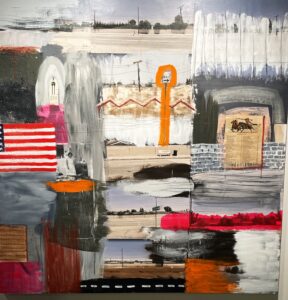
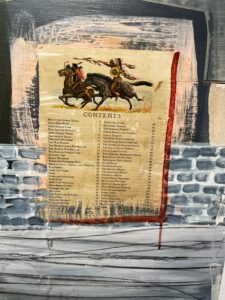
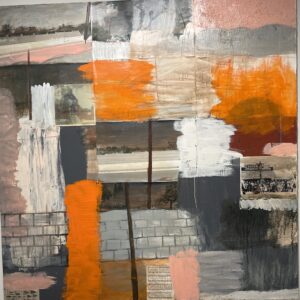
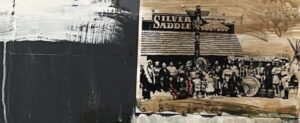
John gave up on organized religion in his twenties, but now he feels that the colonizing of religion still exists inside him. He sees himself as a hybrid.
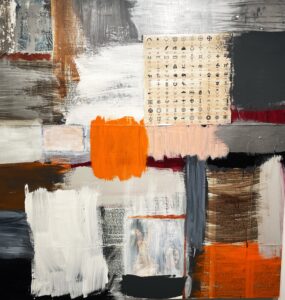
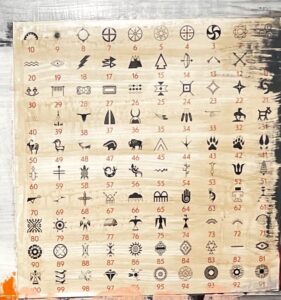
The paintings are actually a dramatic departure for him, featuring large blocks of bright color that make it hard to see the photographs and other images hat he has pasted on the painting. He told me he had recently become interested in De Kooning, who, of course, is part of the colonization of white culture, the great Abstract Expressionists in the 1950s.
But his interest is obviously about the juicy color that swirls around De Kooning’s subjects, almost absorbing them. I can also think of Hans Hofmann with his big blocks of color, but in Hofmann’s case there is rarely any figurative reference. He told me he also looks at Mondrian, Guston, Jaune Quick to See Smith, and Rick Bartow.
Feodorov was moving in the direction of abstraction in the Desecration series, that addressed uranium mining, oil pipelines and coal fracking on Native land. Yellow becomes uranium.
But in “Assimilations” Feodorov’s main point, as it emerges in the color fields, is his own feeling that the Diné beliefs and the white American perceptions of Indians both still exist inside him.
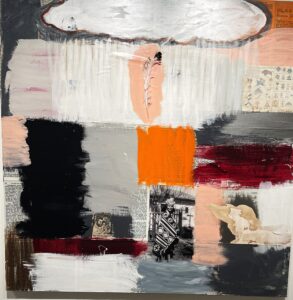
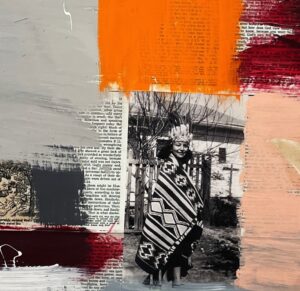
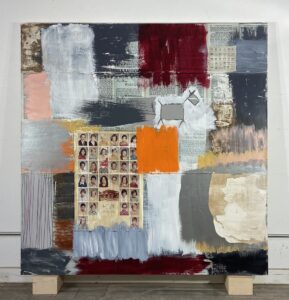
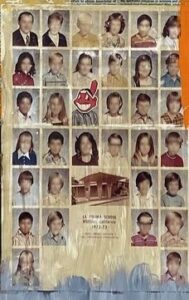
So as we look closely as this dense colorful paintings, we see strange Indian caricatures, “dictionaries” of Indian languages,; a photograph of his mother wearing a Navajo blanket and what appears to be a kitsch headdress, his elementary school class where he is caricatured with a big “Indian” head and much more. The fact that he has closed off the depth with the color squares, is a metaphor for closing off these elements he carries inside himself.
He alternates these paintings with prints based on photographs that juxtapose stills from Wild West movies of cowboys and members of his family on horses in a series called Ambivalence.
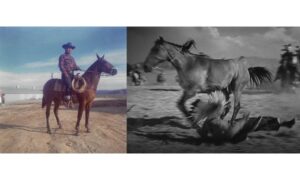

This exhibition includes a work that links to his earlier, more figurative approach My life as a Suburban Ind’n
We see the actual reference points of his early years, especially tv shows and movies caricaturing Indians. The traditional pot with a lace doily on top of the tv epitomizes the contradictions.


The rest of the Assimilations follow the format of large squares of color with racist images just visible. The domination of the color squares over these small Indian caricatures and oddball references speaks to the difficulty of escaping white culture and its caricatures.
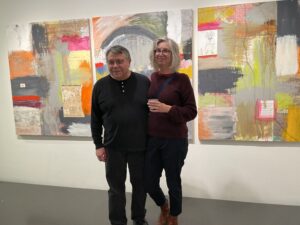
John and Nicole Feodorov in front of his large triptych Memories of a Suburban Ind’n no 1. John Feodorov always seems to be smiling at a private joke, in his art and in his natural disposition, but the joke is actually a very serious awareness on his part that he is never going to escape the colonization of his culture or his own complex position within two cultures. .
This entry was posted on June 12, 2024 and is filed under Uncategorized.








